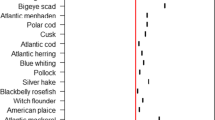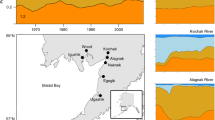Abstract
There is evidence that ocean warming has effects on the ecology, including recruitment dynamics, of marine organisms. In association with rising mean spring temperatures in the Irish Sea, a time-series of juvenile scallop Pecten maximus density around the Isle of Man showed a significant increasing trend since 1991. Favorable conditions (warmer water and correspondingly greater food availability) during gonad development can increase scallop gamete production. We examined the possibility that ocean warming has directly increased recruitment of exploited P. maximus around the Isle of Man by enhancing gonad development. From 1991–2007, there was a significant positive correlation between scallop recruitment and mean spring (the main period of gonad development) temperature in the year of larval settlement. Detrended (i.e., accounting for a time effect) recruitment data showed a marginally non-significant correlation to temperature. Gonadal somatic index of adult scallops and temperature were positively correlated. These relationships support the hypothesis that greater gamete production associated with ocean warming may be primarily responsible for observed increases in recruitment success and CPUE in a commercially important shellfish stock.




Similar content being viewed by others
References
Allen JR, Slinn DJ, Shammon TM, Hartnoll RG, Hawkins SJ (1998) Evidence for eutrophication of the Irish Sea over four decades. Limnol Oceanogr 43:1970–1974
Barbeau MA, Scheibling RE, Hatcher BG, Taylor LH, Hennigar AW (1994) Survival analysis of juvenile tethered sea scallops Placopecten magellanicus in field experiments: effects of predators, scallop size and density, site and season. Mar Ecol Prog Ser 115:243–256
Beukema JJ, Honkoop PJC, Dekker R (2004) Recruitment in Macoma balthica after mild and cold winters and its possible control by egg production and shrimp predation. Hydrobiologia 376:23–34
Beukers-Stewart BD, Mosley MWJ, Brand AR (2003) Population dynamics and predictions in the Isle of Man fishery for the great scallop (Pecten maximus, L.). ICES J Mar Sci 60:224–242
Blythe-Skyrme RE, Hart PJ, Kaiser MJ, Edwards-Jones G, Palmer D (2007) Evidence for greater reproductive output per unit area in areas protected from fishing. Can J Fish Aquat Sci 64:1284–1289
Bowers D, Boudjelas GS, Harker GEL (1998) The distribution of fine suspended sediments in the surface waters of the Irish Sea and its relation to tidal stirring. Int J Remote Sens 19:2789–2805
Brand AR (2006) Scallop ecology: distribution and behavior. In: Shumway SE, Parsons GJ (eds) Scallops: biology, ecology and aquaculture. Developments in Aquaculture and Fisheries Science 35. Elsevier B. V. pp 651–713
Cardinale M, Hjelm J (2006) Marine fish recruitment variability and climate indices. Mar Ecol Prog Ser 309:307–309
Claereboudt MR, Himmelman JH (1996) Recruitment, growth and production of giant scallops (Placopecten magellanicus) along and environmental gradient in Baie de Chaleurs, eastern Canada. Mar Biol 124:661–670
Crisp DJ (ed) (1964). The effects of the severe winter of 1962/63 on marine life in Britain. J Anim Ecol 33:165–210
Ennis GP, Fogarty MJ (1997) Recruitment overfishing reference point for the American lobster, Homarus americanus. Mar Freshw Res 48:1029–1034
Evans GL, Williams PJ Le B, Mitchelson-Jacob EG (2003) Physical and anthropogenic effects on observed long-term nutrient changes in the Irish Sea. Estuar Coast Shelf Sci 57:1159–1168
Gjerdrum C, Vallee AM, St Clair CC, Bertram DF, Ryder JL, Blackburn GS (2003) Tufted puffin reproduction reveals ocean climate variability. Proc Natl Acad Sci USA 100:9377–9382
Gowen RJ, Stewart BM, Mills DK, Elliott P (1995) Regional differences in stratification and its effect on phytoplankton production and biomass in the northwestern Irish Sea. J Plankton Res 17:753–769
Hart DR (2006) Effects of sea stars and crabs on sea scallop Placopecten magellanicus recruitment in the Mid-Atlantic Bight (USA). Mar Ecol Prog Ser 306:209–221
Heilmayer O, Brey T, Portner HO (2004) Growth efficiency and temperature in scallops: a comparative analysis of species adapted to different temperatures. Funct Ecol 18:641–647
Herbert RJH, Hawkins SJ, Sheader M, Southward AJ (2003) Range extension and reproduction of the barnacle Balanus perforatus in the eastern English Channel. J Mar Biol Assoc U.K. 83:73–82
Hiddink JG, ter Hofstede R (2008) Climate induced increases in species richness of marine ecosystems. Global Change Biol 14:453–460
Honaker J, King G, Blackwell M (2006) Amelia software website. http://gking.harvard.edu/amelia
Honkoop PJC, van de Meer J, Beukema JJ, Kwast D (1998) Does temperature-influenced egg production predict the recruitment in the bivalve Macoma balthica? Mar Ecol Prog Ser 164:229–235
Kaiser MJ, Spence FE, Hart PJB (2000) Fishing gear restrictions and conservation of benthic habitat complexity. Conserv Biol 14:1512–1525
Kendall MA, Lewis JR (1986) Temporal and spatial patterns in the recruitment of Gibbula umbilicalis. Hydrobiologia 142:15–22
Laing I (2000) Effect of temperature and ration on growth and condition of king scallop (Pecten maximus) spat. Aquaculture 183:325–334
Lawrence SJ (1993) The feeding ecology and the physiology of the scallops Pecten maximus (L.) and Aequipecten opercularis (L.) in the North Irish Sea. PhD Thesis. University of Liverpool. pp 225
Lindley JA (1998) Diversity, biomass and production of decapod crustacean larvae in a changing environment. Invertebr Reprod Dev 33:209–219
MacDonald BA, Thompson RJ (1985a) Influence of temperature and food availability on the ecological energetics of the giant scallop Placopecten magellanicus. I. Growth rates of shell and somatic tissue. Mar Ecol Prog Ser 25:279–294
MacDonald BA, Thompson RJ (1985b) Influence of temperature and food availability on the ecological energetics of the giant scallop Placopecten magellanicus. II. Reproductive output and total production. Mar Ecol Prog Ser 25:295–303
MacKenzie BR, Koster FW (2004) Fish production and climate: sprat in the Baltic Sea. Ecology 85:784–794
McGarvey R, Serchuk FM, McLaren IA (1993) Spatial and parent-age analysis of stock-recruitment in the Georges Bank sea scallop (Placopecten magellanicus) population. Can J Fish Aquat Sci 50:564–574
Myers R, Barrowman N (1996) Is fish recruitment related to spawner abundance? Fish Bull 94:707–724
Ottersen G, Loeng H, Raknes A (1994) Influence of temperature variability on recruitment of cod in the Barents Sea. ICES Marine Science Symposia 1994
Perry A, Low PJ, Ellis JR, Reynolds JD (2005) Climate change and distribution shifts in marine fishes. Science 308:1912–1915
Philipart CJM, van Aken HM, Beukema JJ, Bos OG, Cadee GC, Dekker R (2003) Climate-related changes in recruitment of the bivalve Macoma balthica. Limnol Oceanogr 48:2171–2185
Pilditch CA, Grant J (1999) Effect of temperature fluctuations and food supply on the growth and metabolism of juvenile sea scallops (Placopecten magellanicus). Mar Biol 134:235–248
Pingree D, Griffiths KD (1978) Tidal fronts on shelf seas around the British Isles. J Geophys Res 83:4615–4622
Powell EN, Mann R (2005) Evidence of recent recruitment in the ocean quahog Arctica islandica in the Mid-Atlantic Bight. J Shellfish Res 24:517–530
Riascos JMV (2006) Effects of El Nino-Southern oscillation on the population dynamics of the tropical bivalve Donax dentifer from Malaga bay, Columbian Pacific. Mar Biol 148:1283–1293
Robinson SMC, Martin JD (2003) A decadal study on the patterns of spawning and settlement of the sea scallop Placopecten magellanicus in the Bay of Fundy. Proceedings of the 14th International Pectinid Workshop, St Petersburg, Florida
Sanford E (1999) Regulation of keystone predation by small changes in ocean temperature. Science 26:2095–2097
Saout C, Quere C, Donval A, Paulet E-M, Samain J-F (1999) An experimental study of the combined effects of temperature and photoperiod on reproductive physiology of Pecten maximus from the Bay of Brest (France). Aquaculture 172:301–314
Sastry AN (1963) Temperature effects in reproduction of the Bay Scallop, Aquipecten irradians Lamarck. Biol Bull 130:118–134
Sims DW, Genner MJ, Southward AJ, Hawkins SJ (2001) Timing of squid migration reflects North Atlantic climate variability. Proc R Soc B 268:2607–2611
Slater J (2005) Spawning of King Scallops, Pecten maximus (L.) in Mulroy Bay and the relationship with spatfall intensity. J Shellfish Res 24:951–958
Southward AJ (1991) 40 years of changes in species composition and population-density of barnacles on a rocky shore near Plymouth. J Mar Biol Assoc U.K. 71:495–513
Steneck RS, Wilson CJ (2001) Large-scale and long-term, spatial and temporal patterns in demography and landings of the American lobster, Homarus americanus. Mar Freshw Res 52:1303–1319
Strasser M, Gunther C-P (2001) Larval supply of predator and prey: temporal mismatch between crabs and bivalves after a severe winter in the Wadden Sea. J Sea Res 46:57–67
Trimmer M, Gowen RJ, Stewart BM, Nedwell DB (1999) The spring bloom and its impact on benthic mineralization rates in western Irish Sea sediments. Mar Ecol Prog Ser 185:37–46
Vahl O (1982) Long-term variations in recruitment of the Iceland scallop, Chlamys islandica from northern Norway. J Sea Res 16:80–87
Votier SC, Bearhop S, Attrill MJ, Oro D (2007) Is climate change the most likely driver of range expansion for a critically endangered top predator in northeast Atlantic waters? Biol Lett 4:204–205
Williams EE (1964) The growth and distribution of Gibbula umbilicalis (Da Costa) on a rocky shore in Wales. J Anim Ecol 33:433–442
Witman JD, Genovese SJ, Bruno JF, McLaughlin JW, Pavlin BI (2003) Massive prey recruitment and the control of rocky subtidal communities on large spatial scales. Ecol Monogr 73:441–462
Wolff M (1988) Spawning and recruitment in the Peruvian scallop Argopecten purpuratus. Mar Ecol Prog Ser 42:213–217
Zeidberg LD, Robison BH (2007) Invasive range expansion by the Humbolt squid, Dosidicus gigas, in the eastern North Pacific. Proc Natl Acad Sci USA 104:12948–12950
Acknowledgments
The authors thank Theresa Shammon for advice on the CYPRIS and RESA datasets. Tom Bryan-Brown (MFPO) and Andy Read (DAFF) provided logistical support and local knowledge. This work was carried out through funding to M. J. Kaiser (University of Bangor) from the Isle of Man DAFF.
Author information
Authors and Affiliations
Corresponding author
Additional information
Communicated by S. D. Connell.
Rights and permissions
About this article
Cite this article
Shephard, S., Beukers-Stewart, B., Hiddink, J.G. et al. Strengthening recruitment of exploited scallops Pecten maximus with ocean warming. Mar Biol 157, 91–97 (2010). https://doi.org/10.1007/s00227-009-1298-7
Received:
Accepted:
Published:
Issue Date:
DOI: https://doi.org/10.1007/s00227-009-1298-7




